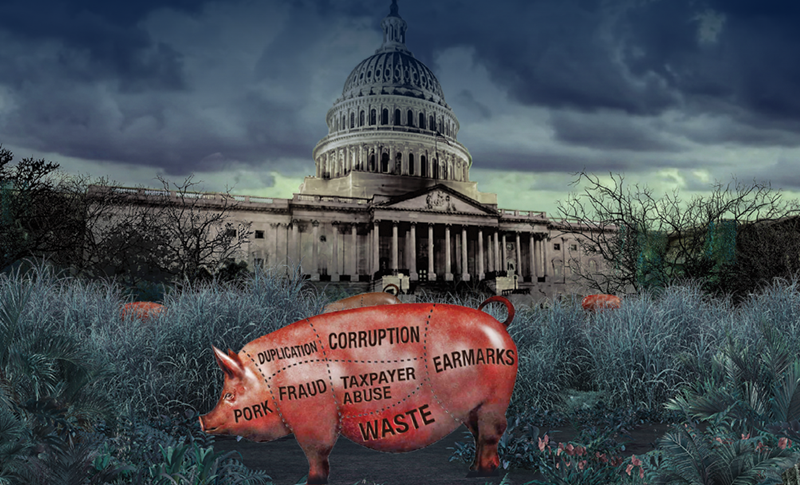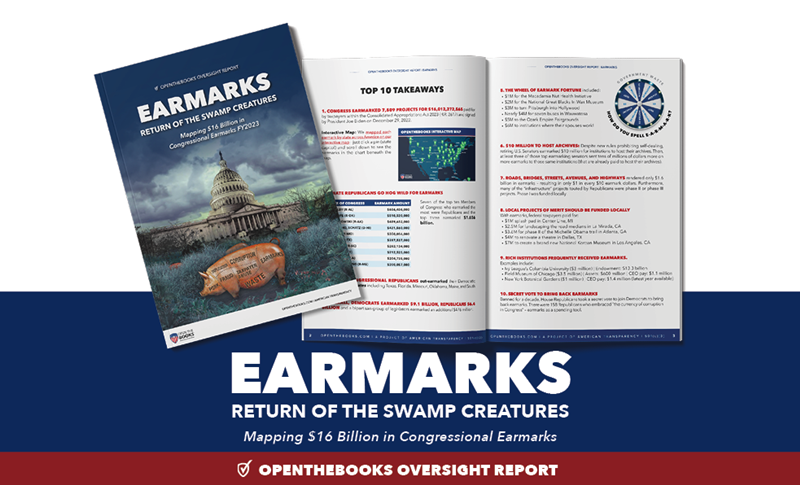

By Adam Andrzejewski, OpenTheBooks CEO/Founder | Published at Substack
PORK. PET PROJECTS. LEGAL BRIBERY. FLEECING. SLEAZE. BRIDGE TO NOWHERE. LOGROLLING. SPENDING SMORGASBORD. BACON. CURRENCY OF CORRUPTION IN CONGRESS. FAVOR FACTORY.
Those are just some of the words and phrases used to describe earmarks.
BACKGROUND
Banned for a decade, in Spring 2021, earmarks returned on a bi-partisan basis when 102 House Republicans took a secret vote to join Pelosi Democrats. Then, in December 2022, then-Leader Kevin McCarthy allowed another secret vote and 158 members voted to keep the pork-barrel spending rolling.
Earmarks help members of Congress “bring home the bacon” and allow federal legislators to set aside specific sums of money for local projects in their states or districts.
In the 2000s, members were being indicted, convicted, and serving jail sentences for corrupt earmarking. Infamously, Randy “Duke” Cunningham (R-San Diego), a bona fide Naval fighter pilot ace, was convicted for doling out earmarks while collecting bribes including a yacht, Rolls Royce, and Louis-Philippe commode.
(Cunningham was given a partial pardon by President Donald Trump during the final hours of his presidency in 2021.)
THE CHEERLEADER
The return of earmarks was cheered on by The Brookings Institution – the largest center-left think tank in DC— who in 2014 published “The Case For Corruption – Why Washington Needs Honest Graft." The white paper argues, in part:
“Politics needs good leaders, but it needs good followers even more, and they don’t come cheap.”
THE CRITIC
“Restoring earmarks in today’s Congress would be like opening a bar tab for a bunch of recovering alcoholics,” published at The Wall Street Journal in a 2014 editorial by U.S. Senator Dr. Tom Coburn.
Coburn was successful spearheading the 2010 earmark ban by partnering with President Barack Obama to stop the “currency of corruption in Congress.”
Even today, every dime of these pet projects is borrowed against our national debt which just crossed $31 trillion, up from less than $6 trillion in 2000.

Our 27 page oversight report on congressional earmarks in the year-end omnibus budget bill FY2023.
OUR OVERSIGHT REPORT
Our OpenTheBooks federal oversight report — Earmarks, The Return of the Swamp Creatures — surveyed the disclosed "member directed” Congressionally Funded Community Projects (CFCP) listed in the Consolidated Appropriations Act 2023 (H.R. 2617) signed by President Biden on December 29, 2022.
Interactive Map: We mapped each earmark by state across America on our interactive map – just click a pin (state capitol) and scroll down to see the earmarks that render in the chart beneath the map.
TOP 10 TAKEAWAYS
1. Congress earmarked 7,509 projects for $16,012,272,565 paid for by taxpayers within the Consolidated Appropriations Act 2023 (H.R. 2617) and signed by President Joe Biden on December 29, 2022.
2. Senate Republicans go hog-wild for earmarks. Seven of the top ten Members of Congress who earmarked the most were Republicans and those seven Republicans earmarked $3.1 billion.
3. In fact, Congressional Republicans out-earmarked their Democratic colleagues in 21 states including Texas, Florida, Missouri, Oklahoma, Maine, and South Carolina.
4. Overall, Democrats earmarks $9.1 billion, Republicans $6.4 billion and a bipartisan group of legislators earmarked an additional $476 million. Crazy earmarks included:
• $1M for the Macadamia Nut Health Initiative • $2M for the National Great Blacks In Wax Museum • $3M to turn Pittsburgh into Hollywood • Nearly $4M for seven buses in Wauwatosa • $5M to the Ozark Empire Fairgrounds • $6M to institutions where their spouses work!
5. The Wheel of Earmark Fortune to retiring members of Congress included:
Retiring U.S. Senator Roy Blunt (R-MO) earmarked $91 million into the University of Missouri ($61 million) and Missouri State University ($30 million). The earmarks funded upgrade projects within buildings previously named after Blunt!
Retiring U.S. Senator Patrick Leahy (D-VT) earmarked $30 million into the University of Vermont (UVM) Honors College. Leahy’s senate archive is hosted at UVM. In March, the university gave Leahy a permanent Presidential Fellowship. In May 2023, the university renamed the honors college after Leahy. The senator also earmarked $34 million into Burlington International Airport and in April 2023 the city council renamed the airport after him.
Retiring U.S. Senator Richard Shelby (R-AL) earmarked $50 million in the University of Alabama, his alma mater and host of Shelby’s senate archive. The earmark funded the university endowment – an $1 billion endowment at a university where the football coach makes $11 million per year.
Retiring Rep. Jim Cooper (D-Nashville) earmarked $2.7 million into projects at Metro-Nashville – where his brother, John Cooper, is the mayor!
6. $10 million to host legislative archives: Despite new rules prohibiting self-dealing, retiring U.S. Senators earmarked $10 million for institutions to host their archives. Then, at least three of those top earmarking senators sent tens of millions of dollars more on more earmarks to those same institutions (that are already paid to host their archives—see Leahy and Shelby above).
7. Local projects of merit should be funded locally — however, with earmarks, federal taxpayers paid for:
• $1M splash pad in Center Line, MI
• $2.5M for landscaping the road medians in La Mirada, CA
• $3M for a parking lot at the Memphis Zoo
• $4M to renovate a theatre in Dallas, TX
• $7M to create a brand new National Korean Museum in Los Angeles, CA
8. Rich institutions frequently received earmarks. Examples include:
• Ivy League’s Columbia University ($3 million) | Endowment: $13.3 billion
• Field Museum of Chicago ($3.5 million) | Assets: $600 million | CEO pay: $1.1 million
• New York Botanical Gardens ($1 million) | CEO pay: $1.4 million (latest year available)
9. Roads, bridges, streets, avenues, and highways rendered only $1.6 billion in earmarks – resulting in only $1 in every $10 earmark dollars.
10. Infrastructure projects, Phase II: We found that typically “phase one” was funded locally. Now, phase II is funded by the federal government and billed off against our national debt.
For example, the Michelle Obama Trail in Georgia was funded by county taxpayers in Dekalb County, Georgia. Phase II is being funded in part by federal taxpayers via a $3.6 million earmark.
In Naples, Florida, Rep. Byron Donald funded Phase II of the Naples septic project with a $5 million earmark. Phase I was funded by local and state taxpayers.
Local projects of merit should be funded locally, not with federal tax dollars.
SUMMARY
By embracing earmarks, Republicans fumbled the first opportunity to distinguish themselves from big-spending Democrats.
Speaker Kevin McCarthy doesn’t request earmarks himself but allowed a secret caucus vote to bring them back.
It’s time for a public, on-the-record, up or down vote on earmarks in the United States House of Representatives. Would all 158 earmark-loving Republicans stick with their secret vote?
There’s only one way to find out.